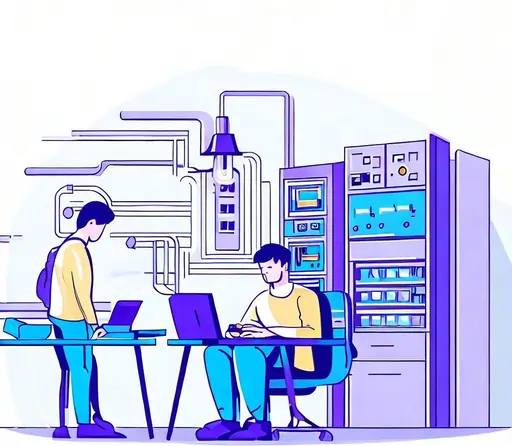Optimizing Power Distribution Systems: Integrating Renewable Energy with MATLAB Projects


Benefits of Renewable Energy Integration
The incorporation of renewable energy sources into power distribution systems not only results in a plethora of benefits, but it also plays a critical part in the development of a resilient and environmentally friendly energy infrastructure. Integration of renewable energy sources, which include solar, wind, and hydropower, brings about reductions in greenhouse gas emissions, mitigates the effects of climate change, and encourages the preservation of the environment. In addition to this, it diversifies the energy mix, which both improves energy security and lessens reliance on the limited fossil fuel resources. In addition to this, the implementation of renewable energy sources contributes to the creation of new jobs, boosts economic growth, and helps communities. Overall, it clears the way for a future that is greener and more sustainable while simultaneously ensuring a power distribution system that is reliable and resilient.
- Reduction of Carbon Footprint
- Enhanced Energy Independence
- Economic Benefits
It is absolutely necessary to incorporate renewable energy sources such as solar and wind into power distribution networks if we are going to make the most of the game-changing opportunity presented by decreasing our reliance on fossil fuels. This integration has the potential to significantly reduce the carbon footprint that is associated with the generation of electricity, thereby paving the way for a cleaner and more sustainable energy landscape. Not only will we be promoting environmental sustainability, but we will also be playing a significant part in reducing the negative effects of climate change. This can be accomplished by shifting towards energy sources that are clean and renewable. We can usher in a greener future by embracing renewable energy as a cornerstone of our power infrastructure. This will allow us to usher in a future that is marked by a significant reduction in emissions of greenhouse gases as well as a steadfast commitment to sustainable practices.
Integration of renewable energy sources offers a number of significant benefits, one of the most significant of which is its role in fostering energy independence through the diversification of the energy mix. Enhancing a region's overall energy security can be accomplished by lowering its reliance on fossil fuels that are imported. When it comes to the geopolitical tensions and economic ups and downs that are associated with the markets for fossil fuels, power distribution systems that are effectively integrated with renewable energy sources are less likely to be affected. Communities and nations can achieve greater control over their energy supply and, as a result, their power infrastructure can become more stable and resilient, allowing them to better withstand unanticipated challenges and uncertainties in the global energy landscape. This control can be achieved by harnessing local and renewable sources of energy.
The incorporation of renewable energy sources has been shown to have significant and positively impactful economic repercussions. Power distribution systems are now in a position to make use of renewable resources for the generation of electricity at a lower cost as a result of the ongoing decline in the cost of renewable technologies. Communities can lessen their reliance on costly fossil fuel imports and realize long-term reductions in their energy costs by increasing their utilization of renewable energy sources. Additionally, the construction and upkeep of renewable energy infrastructure produce a domino effect in the economy, which results in the creation of employment opportunities in a variety of different industries, the stimulation of local economies, and the promotion of sustainable growth. The sector of renewable energy acts as a catalyst for economic change, driving innovation, attracting investments, and positioning regions at the forefront of the transition to greener forms of energy.
Optimization Techniques for Renewable Energy Integration
Integration of renewable energy sources into power distribution systems in an effective manner calls for careful planning and optimization strategies to be implemented. In this regard, MATLAB projects provide a comprehensive toolkit that includes cutting-edge tools and methodologies that are designed to tackle the complexities of integrating renewable energy sources. Utilizing the capabilities that MATLAB provides, researchers and academics are able to investigate and put into practice optimization strategies that are adapted to the particular needs of power distribution systems. MATLAB projects give users the ability to navigate the complex challenges that are associated with the integration of renewable energy sources. These challenges include the optimal sizing and placement of renewable generation units, as well as optimal power flow optimization algorithms and energy storage optimization strategies. Researchers are able to uncover novel insights and drive forward advancements in the optimization of power distribution systems with the integration of renewable energy sources when they make use of the optimization capabilities offered by MATLAB.
- Power Flow Optimization
- Energy Storage Optimization
- Optimal Siting and Sizing of Renewable Generation
In order for power distribution systems to function effectively, power flow optimization is an essential component, particularly when intermittent renewable energy sources are being integrated into the system. Researchers now have access to a plethora of algorithms and optimization frameworks thanks to MATLAB projects, allowing them to effectively tackle this challenge. Researchers are able to reduce the amount of power that is lost in the power distribution system, reduce the amount of voltage deviations that occur, and ensure that renewable resources are used to their fullest potential when they make use of MATLAB's capabilities. These optimization strategies make it possible to achieve the highest possible level of system efficiency while also making the most out of the integration of renewable energy sources. Researchers are given the ability to optimize power flow, improve system performance, and pave the way for a power distribution infrastructure that is both sustainable and reliable through the use of MATLAB projects.
Within power distribution networks that incorporate renewable energy sources, energy storage systems play an essential role in stabilizing the relationship between supply and demand of electrical power. MATLAB projects give researchers access to a wide variety of tools, which enables them to improve the efficiency of energy storage systems. Researchers are able to determine the optimal storage capacity, come up with efficient charging and discharging strategies, and evaluate the performance of the system as a whole by leveraging the capabilities of MATLAB. By using these optimization techniques, researchers are able to achieve a balance between the generation of energy and its consumption, which improves the stability of the grid and ensures a reliable supply of power. MATLAB projects play a significant part in determining the deployment and operation of energy storage systems, which in turn supports the incorporation of renewable energy sources into power distribution networks.
In order to extract the maximum value from the integration of renewable energy sources, it is necessary to give careful thought to the optimal locations and sizes for renewable generation units. Researchers have access to powerful capabilities through MATLAB projects, allowing them to carry out comprehensive site selection and sizing analyses. Researchers are able to evaluate a variety of factors by utilizing the tools provided by MATLAB. These factors include solar irradiance, wind speed, geographical constraints, and load profiles. With the help of these analyses, researchers are able to pinpoint the areas that are best suited for the installation of renewable generation units as well as the dimensions that offer the greatest potential for increasing the amount of energy produced. Projects built in MATLAB play an important part in informing decision-making processes, which in turn helps to optimize the integration of renewable energy sources into power distribution networks for improved performance and long-term sustainability.
Challenges in Optimizing Power Distribution Systems
Although the optimization of power distribution systems through the integration of renewable energy sources presents a significant number of benefits, it is essential to address a number of important challenges. Incorporating efficient energy management strategies, managing the intermittent and variable nature of renewable energy sources, and ensuring the stability and quality of the power grid are all important factors to take into consideration. In addition, the integration of renewable energy sources necessitates the existence of robust regulatory frameworks, policies that are supportive, and adequate investments in infrastructure. Both theorists and practitioners have a responsibility to address technological constraints, such as storage capacity and grid compatibility. We can develop innovative solutions and strategies to optimize power distribution systems if we acknowledge and work to address these challenges. This will make it possible for the seamless integration of renewable energy sources and will bring about a sustainable energy future.
- Intermittency and Variability
- Grid Stability and Power Quality
The intermittent and variable generation patterns of renewable energy sources present challenges for the operation and optimization of power distribution systems. These challenges must be overcome in order to maximize efficiency. MATLAB projects provide researchers and practitioners with a wide variety of tools that can accurately model and simulate the aforementioned characteristics. Researchers are able to develop strategies to effectively manage the intermittency and variability of renewable energy generation by making use of the capabilities provided by MATLAB. These tools make it possible to explore and analyze a variety of different scenarios, which in turn makes it possible to develop sophisticated techniques for forecasting, optimal strategies for dispatching, and intelligent control algorithms. Researchers are given the ability to address the challenges that are associated with intermittent renewable energy sources through the use of MATLAB projects. This, in turn, makes it possible for renewable energy sources to be integrated into power distribution systems in a manner that is more streamlined and effective.
Because of the inherently variable nature of renewable generation, the incorporation of renewable energy sources into power distribution systems can raise concerns regarding the systems' ability to maintain stability and maintain adequate power quality. Nevertheless, MATLAB projects give researchers access to sophisticated control and optimization strategies, which they can use to effectively address these challenges. Researchers are able to develop advanced control algorithms and optimization strategies for the purpose of ensuring the stability of the grid and a reliable supply of power by utilizing the capabilities of MATLAB. These methods make it possible to integrate renewable energy sources without disrupting the system's stability, voltage regulation, or power quality standards. They do this by allowing for seamless integration. Researchers are given the ability to address stability and power quality issues through the use of MATLAB projects, which makes it easier for renewable energy to be successfully integrated into power distribution systems.
Conclusion
When it comes to achieving a smooth integration of renewable energy sources into existing power distribution networks, optimization is of the utmost significance. Researchers and PhD students have access to an invaluable resource in the form of MATLAB projects, which provide them with effective tools to combat the intricate complexities associated with the integration of renewable energy sources. Power distribution systems are able to improve their operational efficiency, reduce their negative impact on the environment, and strengthen their ability to withstand disruptions when they make use of the sophisticated optimization methods made available by MATLAB projects. The never-ending improvements made to MATLAB projects encourage innovation, which in turn drives the optimization of power distribution systems to new heights and paves the way for a cleaner and more sustainable energy future.